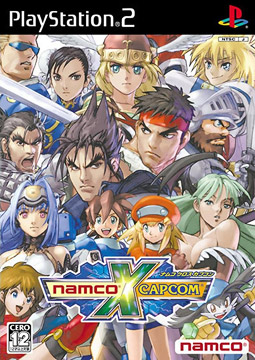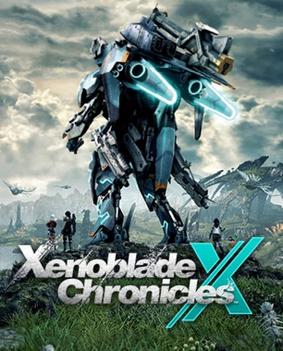Xenosaga is a role-playing video game series developed by Monolith Soft and primarily published by Namco. Forming part of the wider Xeno metaseries, Xenosaga is set in a science fiction universe and follows a group of characters as they face both a hostile alien race called the Gnosis and human factions fighting for control of the Zohar, an artifact connected to a god-like energy called U-DO. Gameplay across the series is similar, with the characters being guided through a linear narrative and fighting enemies using a turn-based combat system. The party fights both on foot and in a variety of mechs.

KOS-MOS is a fictional character from the Xenosaga role-playing video game series by Monolith Soft and Bandai Namco Entertainment. KOS-MOS also appears as a major character in the anime Xenosaga: The Animation and in several crossover video games.

Baten Kaitos: Eternal Wings and the Lost Ocean is a role-playing video game developed by Monolith Soft and tri-Crescendo and published by Namco for the GameCube. In it, the player assume the role of a "guardian spirit" – an unseen player avatar – who guides protagonist Kalas and his party of companions in an adventure across an aerial floating island-based kingdom in the clouds. The game is focused around the concept of "Magnus" – magical cards that capture the "essence" of items found in the in-game world. The concept is used as a plot device, for in-game item management, and as a basis for the card-themed battle system. The game was noted for its unique battle system, which included aspects of turn-based and action-based battle systems, collectible card games, and poker.
Tetsuya Takahashi is a Japanese video game designer, writer and director. Takahashi worked at Square in the 90s as a graphic designer and graphic director, participating on some of their most well-received titles such as Final Fantasy V, Final Fantasy VI and Chrono Trigger, before directing and co-writing Xenogears. He left Square in 1999 to co-found Monolith Soft, where he would develop the Xenosaga and Xenoblade Chronicles series with Namco and Nintendo respectively, being the executive director of Xenoblade since the first entry in the series.

Xenosaga I & II is a 2006 role-playing video game co-developed by Monolith Soft and Tom Create, and published by Namco for the Nintendo DS. A spin-off of the Xenosaga trilogy and forming part of the Xeno metaseries, Xenosaga I & II retells the events of Xenosaga Episode I and Xenosaga Episode II while expanding on its characters and narrative. Displayed from an angled two-dimensional perspective, Xenosaga I & II makes use of a turn-based battle system with elements carried over from the main Xenosaga games.

Namco × Capcom is a tactical role-playing (RPG) crossover video game developed by Monolith Soft for the PlayStation 2 and published by Namco in 2005. The gameplay combines tactical RPG and action sequences during battles, featuring characters from video game series owned by Namco and Capcom. The narrative sees original characters Reiji Arisu and Xiaomu, operatives for paranormal investigative group Shinra, confront distortions bringing characters from other realities into their own.

Baten Kaitos Origins, released in Japan as Baten Kaitos II, is a 2006 role-playing video game developed by Monolith Soft and Tri-Crescendo for the GameCube. It is a prequel to Baten Kaitos: Eternal Wings and the Lost Ocean (2003). Similar to the first entry, the player assume the role of a "guardian spirit" – an unseen player avatar – who guides protagonist Sagi and his party of companions in an adventure across an aerial floating island-based kingdom in the clouds. The game retains the original's focus around the concept of "Magnus" – magical cards that capture the "essence" of items found in the in-game world, where the concept is still used as a plot device, for in-game item management, and as a basis for the card-themed battle system, albeit with minor tweaks.

Xenosaga: Pied Piper is a 2004 role-playing video game co-developed by Monolith Soft, Namco, and Tom Create. The game was published by Namco in 2004 for mobile devices. A spin-off of the Xenosaga trilogy and forming part of the Xeno metaseries, the storyline follows the human life of cyborg Ziggurat 8—a key character in the Xenosaga trilogy—a century before the events of Xenosaga Episode I. Gameplay follows a similar system to the mainline Xenosaga games but adjusted for mobile devices.

Xenosaga Episode I: Der Wille zur Macht is a role-playing video game developed by Monolith Soft and published by Namco for the PlayStation 2; the game was released in 2002 in Japan and 2003 in North America. It is the first entry in the Xenosaga trilogy and forms part of the wider Xeno metaseries. Gameplay features exploration of environments through a linear narrative, while battles use turn-based combat with the player characters fighting both on foot and piloting large mecha dubbed A.G.W.S.; combat in turn features a system of button combinations for attack types, and multiple leveling systems.

Xenosaga Episode II: Jenseits von Gut und Böse is a 2004 role-playing video game developed by Monolith Soft for the PlayStation 2. It was published in Japan (2004) and North America (2005) by Namco, and in Europe by Sony Computer Entertainment Europe (2005). It is the second entry in the Xenosaga trilogy, and forms part of the wider Xeno metaseries. Continuing directly from the events of Xenosaga Episode I, Xenosaga Episode II sees protagonists Shion Uzuki and Jr. continuing to combat the plots of the U-TIC Organization and the insane Albedo Piazzolla. Gameplay is carried over from the first game, featuring exploration of environments through a linear narrative, while battles follow a turn-based system featuring a system of button combinations, multiple leveling systems, and combat featuring both the characters on foot and piloting large mecha called "E.S.".

Xenosaga Episode III: Also sprach Zarathustra is a role-playing video game developed by Monolith Soft and published by Namco Bandai Games for the PlayStation 2 in 2006. It is the final entry in both the Xenosaga trilogy and the larger Xenosaga series, which forms part of the Xeno franchise. Concluding the narrative of Xenosaga Episode I and Episode II, Episode III sees Shion Uzuki and the battle android KOS-MOS search out the origins of the hostile alien Gnosis while being hunted by Shion's former employers and four powerful humans called the Testaments. Gameplay is carried over from the first two games, featuring exploration of environments through a linear narrative, while battles follow a turn-based system featuring multiple leveling systems and combat with both a human party and mecha.
Yasuyuki Honne is a video game artist, director and producer. He was employed by Square from 1993 to 1999 and is now working at Monolith Soft. He is known for his work on the Chrono series, Xeno games and Baten Kaitos series.

Xenoblade Chronicles is an action role-playing game developed by Monolith Soft and published by Nintendo for the Wii. Initially released in Japan in 2010, it was later released in the PAL regions in 2011 and in North America in 2012. A port for the New Nintendo 3DS was released in 2015, and a remaster for the Nintendo Switch, titled Xenoblade Chronicles: Definitive Edition, was released in May 2020. Xenoblade Chronicles is the first entry in the Xenoblade Chronicles series, a subseries which forms part of the larger Xeno metaseries. Although it lacks direct narrative connections to previous Xeno games, like them, it incorporates aesthetic and narrative elements from both fantasy and science fiction. The game features navigation through an open world split into zones, side-quests tied to party members' affinity, and a real-time action-based battle system which incorporates Shulk's ability to see brief glimpses of the future.

Xeno is a Japanese science fantasy video game franchise created by Tetsuya Takahashi. The first entry was developed by SquareSoft, and subsequent entries have been developed by Monolith Soft, a company founded by Takahashi after he left Square in 1999. While the various games have no direct story connections, they have common thematic links and all sport the "Xeno" prefix, which Takahashi has variously described as a means of identifying his games and a symbolic representation of the series. All the games in the Xeno meta series take place within a science fiction setting with some fantasy elements, with its stories frequently featuring psychological, philosophical, and religious themes.

Xenoblade Chronicles X is a 2015 action role-playing game developed by Monolith Soft and published by Nintendo for the Wii U console. The game is part of the Xenoblade Chronicles series, itself forming part of the wider Xeno metaseries. Carrying over several gameplay elements from the original game, players explore the open world planet Mira, completing a variety of quests and unlocking new regions to explore and gather resources from across its five continents. The story follows a surviving human ship after escaping an alien battle which destroys Earth, with the player character joining the BLADE unit to defend the human survivors and uncover Mira's secrets.
B.B. Studio Co., Ltd. is a Japanese video game development company. The company is a result of a merger between BEC and Banpresoft by their parent company, Bandai Namco Entertainment.

Xenoblade Chronicles 2 is a 2017 action role-playing game developed by Monolith Soft and published by Nintendo for the Nintendo Switch. It is the third installment in the Xenoblade Chronicles series and the sixth main entry in the Xeno series, and was released on December 1. Plans for the game began shortly before the launch of Xenoblade Chronicles X in 2014. Key developers from previous games returned, including franchise creator Tetsuya Takahashi and directors Koh Kojima and Genki Yokota. The team wanted to develop a story-driven game in the style of the original Xenoblade Chronicles. The game was announced in 2017 and was released worldwide the same year. As with Xenoblade Chronicles, the game was localized by Nintendo of Europe.

Xenoblade Chronicles is a series of action role-playing games developed by Monolith Soft and published by Nintendo. The series began with the original Xenoblade Chronicles game, published for the Wii in 2010 in Japan, and released in Europe and Oceania the following year. Nintendo originally had no plans for a North American release, but after a fan campaign named Operation Rainfall showed sufficient interest, the game was eventually released in the region in 2012. The original game became a critical and commercial success, spawning multiple sequels. The series has since sold more than 8.74 million copies worldwide. Xenoblade Chronicles has been well-received for its world design, music, stories, and themes. The series has been represented in other gaming franchises, including the Super Smash Bros. and Project X Zone series. It is loosely a part of the Xeno metaseries, for which it receives its namesake, co-created and directed by Tetsuya Takahashi.

Xenoblade Chronicles 3 is a 2022 action role-playing game developed by Monolith Soft and published by Nintendo for the Nintendo Switch. It is an installment in the open-world Xenoblade Chronicles series, itself a part of the larger Xeno franchise. Xenoblade Chronicles 3 depicts the futures of the worlds featured in Xenoblade Chronicles (2010) and Xenoblade Chronicles 2 (2017) and concludes the trilogy's narrative.














